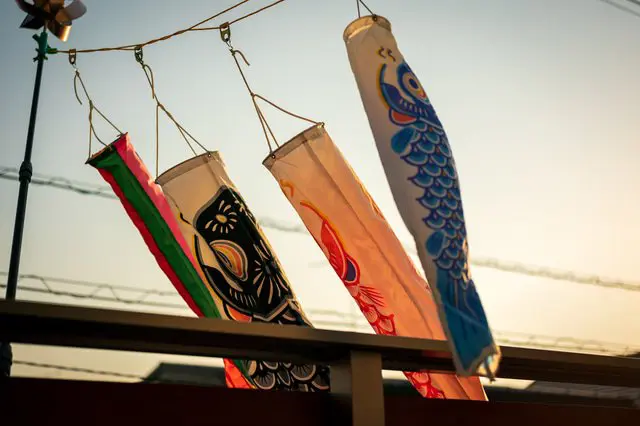Koinobori Carp Streamers: Celebrating Children's Day in Japan

Koinobori, or "carp streamers," are traditional windsocks displayed ahead of Children's Day (May 5) in Japan. We introduce the background and significance of this custom, along with famous Koinobori displays in Tokyo and other places in Japan.

Koinobori, also known as carp banners or carp streamers are traditional decorations displayed outdoors ahead of Chinldren's Day (May 5). You may spot these decorations in front of private homes; parents display them as a wish for their children to grow strong and healthy just like the carp, which are said to be able to swim upstream.
Gorgeous displays of koinobori banners can also be found in public places, especially over rivers. Tokyo Tower has a famous annual display of 333 koinobori, a number that coincides with the height of the tower in meters!
In this article, we will explore the longstanding customs associated with koinobori that date back to the Edo period (1603 - 1868) and introduce a few famous locations with beautiful koinobori displays.
What Is a Koinobori?
A koinobori is a windsock shaped like a carp, often flown in elevated spaces to create the illusion of fish swimming in the sky.
These vibrant decorations can be spotted all across Japan, whether in urban areas, rural landscapes, tourist spots, or local communities—essentially, they adorn every corner of the country.
Some koinobori can be as long as eight meters, and observing these larger versions up close is truly remarkable.
The Origin of Koinobori
Symbolizing the Healthy Growth of Children
The tradition of Koinobori streamers traces its roots back to the desire for the robust development of boys. During the era of the samurai, these decorative items symbolized parents' hopes for their sons to mature into resilient warriors.
In contemporary times, the practice has evolved to include both male and female children in the family, making it customary to display Koinobori to celebrate the growth and prosperity of all children.
Origins of the Streamer
The initial koinobori were crafted by ordinary individuals during the mid-Edo period, inspired by the nobori flags of the war-torn Sengoku era utilized in warfare to differentiate allies from adversaries.
Significance of the Carp
According to Chinese folklore, a carp that scales a vigorous waterfall transforms into a dragon. This myth influenced the people of the Edo period to adopt the carp as a symbol of good fortune for children.
Famous Koinobori Displays in Japan

In Tokyo, the Koinobori display at Tokyo Tower with its 333 carp banners can be enjoyed every year from March 20 until May 6.
Tokyo Skytree also boasts a beautiful Koinobori display with 1,500 carp streamers along the river on the southern side of the tower. This event is usually held during Golden Week, from April 29 until May 5.

One of the most impressive Koinobori displays in Japan is held at the Ryujin Great Bridge in Hitachiota City, Ibaraki. This pedestrian bridge suspended over the dragon-shaped Ryujin Gorge is famous as a prime destination for bungee jumping.
In spring, however, the impressive row of Koinobori streamers displayed along the bridge is a highlight that shouldn't be missed!
The city of Obuse in Nagano is also famous for its Koinobori displays that coincide with the cherry blossom season in the area.
These colorful displays are a symbol of spring in Japan so why not hop on a train and capture them in beautiful photos amid breathtaking nature?
Read also
More and More Koinobori

As mentioned earlier, koinobori are traditionally flown to symbolize children's healthy growth. Following the post-war population increase in Japan, these streamers became a common sight nationwide.
In recent times, the once ubiquitous display of koinobori in local residences, parks, and tourist spots has dwindled, likely influenced by Japan's declining birthrate. Yet, a noticeable shift has occurred in the past few years. The resurgence of these windsocks serves as a beacon of hope for future generations.
Although some observe a decreasing presence of koinobori, stemming partly from the demographic challenges, adults can still partake in this tradition. They can erect these symbolic carp not just to commemorate their childhood memories but also to pass on their cherished streamers to a new era, fostering continuity and a link to the past.

Koinobori sets typically include a father, mother, and child carp, with each carp decreasing slightly in size. When a new family member arrives, a smaller carp is traditionally added.
Many families resort to purchasing snacks from supermarkets that come with miniature koinobori toys to supplement their display. It's not uncommon to spot these diminutive versions fluttering next door.
If you pass by Japanese housing complexes in early May, you might notice koinobori banners gracefully adorning the skies. We hope you enjoy koinbori-spotting in spring in Japan!
Read also
All pictures from PIXTA
This is the official account of MATCHA's editorial department. Our articles feature useful travel information for visitors to Japan, from how-to guides to recommended places to visit.









































![[2026] Top 5 Strawberry Picking Spots in Tokushima, Naruto| Farms and Access Guide for January to May](https://resources.matcha-jp.com/resize/720x2000/2025/03/06-227165.webp)

